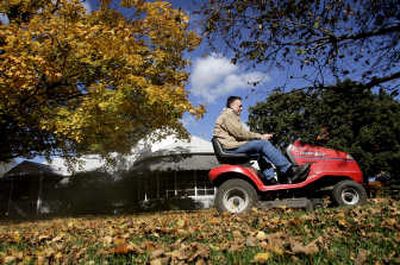Making sense of mulch for your situation

Most gardeners know the benefits of mulch. Mulch can block weeds from germinating, retain moisture in the soil and keep plants from burning up in summer.
Not so well known are the differences between types of mulch: Are organic mulches better than inorganic ones for your garden? Are wood chips better than shredded wood?
ORGANIC COMPOST
Advantages: Some weed control and moisture retention. Organic gardeners say it blocks bacteria and fungi from infecting plants. No tilling required. Acts as slow-release fertilizer as it breaks down. You can make your own.
Disadvantages: Weeds may thrive in its rich material. Relatively expensive if purchased. Not as attractive as some other mulches.
•Grass Clippings
Advantages: Some weed control. Warms soil. Holds in moisture. Feeds plants and improves soil when tilled in. Free.
Disadvantages: Can heat bed too much in summer. Can cause rot if too close to plant stems or tree trunks. May contain weed seeds. Use only when dry — can lead to stinky, anaerobic conditions if used when wet. Use herbicides on your lawn? if so, don’t use grass clippings on veggies.
•Hay
Advantages: Controls weeds. Cheap. Keeps soil temps even and cool. Holds in moisture. Improves soil texture when tilled in. Lasts a long time. Prevents splashup of soil-borne disease spores. Alfalfa is best kind, says organic expert Howard Garrett.
Disadvantages: Can contain weed seeds. Lacks nutrients. In most instances, is not attractive in ornamental plantings unless chopped.
•Newspaper
Advantages: Excellent weed control. Free. Can use whole or shredded (sold commercially in nuggets). Retains moisture. Keeps soil temps even and cool. Long-lasting if used in stacks; cover with a thin layer of straw or bark to improve appearance and keep layers from blowing away. Builds humus. Trace minerals in ink beneficial.
Disadvantages: Can create anaerobic conditions when used in stacks. Does not improve soil texture unless tilled in, but then ties up nitrogen in order to decompose. Ugly unless covered.
•Peat Moss
Advantages: Fine texture and good color.
Disadvantages: Tendency to dry out and become impervious to water. Expensive. Tendency to blow away.
•Pecan or Peanut Hulls
Advantages: Attractive, coarse-looking mulch. Decomposes rapidly to add humus to soil.
Disadvantages: Decomposes rapidly. May be attractive to rodents if hulls aren’t completely free of nuts.
•Pine Needles
Advantages: Especially attractive as top-dressing. Supplies nutrients as it decomposes. Especially good for acid-loving plants such as azaleas, gardenias and hydrangeas.
Disadvantages: Doesn’t break down quickly to supply nutrients.
•Sawdust
Advantages: Easily to find in many areas. Easy to handle.
Disadvantages: Can deplete nitrogen if not well rotted and aged. Supplemental nitrogen fertilizing may be necessary.
•Shredded Bark
Advantages: Very long lasting. Attractive. Retains moisture. Keeps soil temperature even and cool. Hardwood bark holds in place yet allows air to circulate. Cypress, especially, resists floating away.
Disadvantages: Comparative-ly expensive. Can exude chemicals that harm tomato plants. Nutrient poor. Mr. Garrett says cypress mulch tends to mat and seal off a bit more oxygen than he likes and breaks down slowly. Pine bark can plate together and seal off oxygen; wind and water can move it.
•Shredded Leaves
Advantages: Free. Retains moisture. Keeps soil temperature even and cool. May add nutrients and humus to soil. Can run a mower with attached bag to collect them.
Disadvantages: Weed control only moderate. Some labor involved, as leaves should be shredded (whole leaves can smother emerging plants in spring). Slugs can hide in it.
•Wood Chips
Advantages: Stays put through wind and rain. Retains moisture. Controls weeds. Good to cover large areas. Good looking when aged. Often free from municipalities and tree-removal companies. Long-lasting.
Disadvantages: Does not improve soil texture unless tilled in, but then ties up nitrogen in order to decompose.
INORGANIC
•Black Plastic
Advantages: Very effective weed control. Cheap. Warms soil. Retains moisture.
Disadvantages: Short useful life. Repels water. Kills anything, including earthworms. Winds up in landfills. No soil nourishment. Ugly unless covered with something.
•Porous Landscape Fabric
Advantages: Very effective weed control. Cheap. Warms soil. Holds in moisture without excluding air or water. Can go under decorative mulches.
Disadvantages: Ends up in landfill. No soil nourishment.
•Rock: Crushed, Whole
Advantages: Available in many colors and sizes. Permanent; does not require replenishing as frequently as organic materials. Useful around plants subject to crown rot.
Disadvantages: No nutrients. Doesn’t biodegrade. Can be difficult to clean, especially under pine or other very small-leaved evergreens. White rock reflects light and may heat up surroundings. Black rock absorbs heat. More expensive than organic mulches.
•Pea Gravel
Advantages: Attractive. Permanent. Can be re-used indefinitely. Especially useful in utility areas.
Disadvantages: No soil nourishment. Doesn’t biodegrade.
•Aluminum Foil
Advantages: Blocks varmints because of crinkling noise and feel underfoot. Reflective surface reportedly repels aphids. Relatively inexpensive.
Disadvantages: Ugly. Can suffer wind damage if not weighted down with soil. Tears easily if walked on.